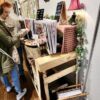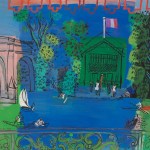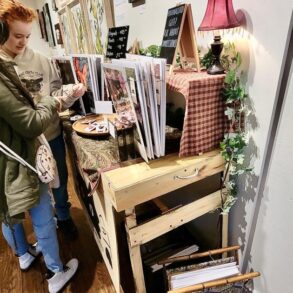The 14th edition of ArtRio, Brazil’s second largest art fair and one the most important in Latin America, seems to be surprising a lot of visitors and local insiders. Despite the overall feeling of a slowdown in the global art market, this was not the overall impression for those at the fair’s preview at the Marina da Glória in Rio de Janeiro on Wednesday.
“I hear that the world’s art markets are slowing down, but seeing this first day here at ArtRio, I can absolutely say that the Brazilian market is not slowing down at all,” Brenda Valansi, founder of ArtRio, told ARTnews.
Isadora Ganem, a São Paulo–based director at Mendes Wood DM, one of Brazil’s top galleries with locations in New York, Paris, and Brussels, agreed. “The Brazilian art market is healthy and steady,” she told ARTnews.
For Ganem there are two perspectives on the Brazilian market. One that is the Brazilian art market itself and another that takes into consideration Brazilian art in the global art scene. “The Brazilian art market is still very local but is growing. There are many new galleries, and we are seeing galleries starting in other [Brazilian] cities outside the São Paulo-Rio axis,” she said.
With more than 80 national and international galleries as well as art institutions, the fair follows the recipe of earlier editions, with two main pavilions: Mar and Terra (Ocean and Land).
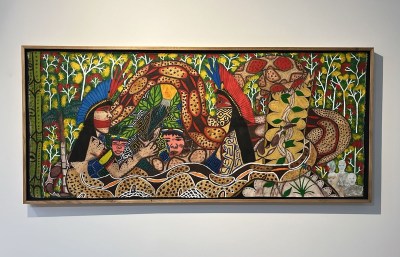
Acelino Sales (MAKHU member), Yube Nawa Aibu, 2023.
Courtesy ArtRio
In the Mar pavilion, ArtRio brings back its Brasil Contemporâneo program after a five-year hiatus. Aimed at promoting galleries from places outside the axis of Rio and São Paulo, this year’s program has a strong presence of Indigenous artists, including members of the MAHKU collective (Huni Kuin Artists Movement), who are based in Kaxinawá (Huni Kuin) Indigenous Territory of the northwest state of Acre and who created a mural on the exterior of Central Pavilion at this year’s Venice Biennale. Cleiber Bane, Acelino Sales, and Cleudon Txana Tuin each had on view a painting in the booth of Carmo Johnson Project.
The Mar pavilion also features the fair’s Solo, focusing on single-artist presentations, and Mira sections, for video art projections, selected this year in partnership with the Pérez Art Museum Miami. The Terra pavilion, on the other hand, feature the traditional Panorama section, of blue-chip galleries focusing on modern and contemporary art. Outdoors, overlooking Guanabara Bay, a sculpture garden displays large-scale works, by Ascânio MMM, Amilcar de Castro, and others.
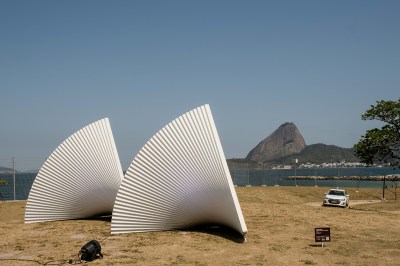
Ascanio MMM’s Velas (2000) installed in the sculpture garden outside ArtRio.
Courtesy ArtRio
This year’s opening day saw 50 international collectors and curators, from places like France, Switzerland, Italy, and the United States, came to Rio, according to the fair. This surge in international visitors, Valansi noted, reinforces the fair’s main objective this year in showcasing Brazilian art to the international public, rather than bringing international galleries to the Brazilian public.
“We have seen a great deal of international interest in Brazilian art, precisely because the world is looking for other narratives,” she said. “Everyone wants to see these Brazilian stories.”
Inside the fair during the VIP opening, any feeling of a sluggish art market was far from anyone’s mind. By sunset, the two pavilions were buzzing with interested buyers. “This is the first day and there is already a lot of interest, with a lot of people asking about prices of works,” said Camila Tomé, a director at Rio’s Galeria Athena.
For Valansi, although the world’s art market seems a bit shaky, the Brazilian art market remains quite solid. “Over the years we have seen peaks and valleys, but on average it has remained stable,” she said.
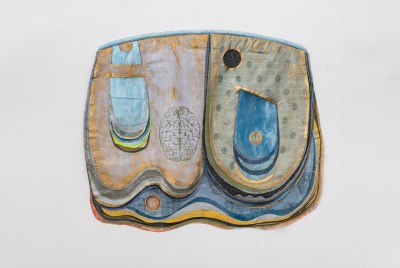
Leda Catunda’s Cérebro (2023) in the booth of Fortes D’Aloia & Gabriel.
Photo: Eduardo Ortega/Courtesy Fortes D’Aloia & Gabriel
From the international point of view, Ganem, the Mendes Wood DM director, said the world is much more open to Brazilian art. “We are seeing an increase of presence of Brazilian art galleries in international art fairs,” she said. “We are also seeing an increase of Brazilian artists represented by international galleries as well.”
Part of this, Ganem said, may have to do with this year’s Venice Biennale, which was for the first time organized by a curator from Latin America, Adriano Pedrosa, the artistic director of the Museu de Arte de São Paulo. His exhibition, “Foreigners Everywhere,” spotlighted hundreds from artists from the Global South, many of them Brazilian.
“We had this year, a crazy number of [foreign] curators visiting Brazil, so we can say from a local perspective that there’s a great interest in Brazilian art right now,” she said.

The scene during the opening day at the 2024 edition of the ArtRio Art Fair.
Courtesy ArtRio
The number of foreign visitors this first day of ArtRio was not really a surprise for Alessandra D’Aloia, one of the founding partners at Fortes D’Aloia & Gabriel, which has locations in Rio and São Paulo.
“I think that we are at a very special moment in Brazil. It’s not only about European and American art anymore,” said D’Aloia, noting that now there is more of a focus on “Indigenous, popular art, and other icons that we carry in our art [in Brazil]. There are so many references from our culture in international fairs nowadays and I think we attract a lot of international audiences to Brazilian art.”
For D’Aloia, Brazil is currently a very hot market, and it doesn’t seem it will be slowing down anytime soon. “If you are a serious gallery, if you are doing a good job in Brazil, I think you have a very special audience buying Brazilian art,” she said.

Ayla Tavares’s Dorsal Oceânica (2024) in the booth of Galeria Athena.
Photo Thiago Almeida
Tomé, from Galeria Athena, added that international collectors seemed to be especially interested in artists whose work explores the complexities of Brazilian identity.
“We’re sensing that a lot of collectors from abroad are coming very focused on this type of artist as well as a lot of young artists, with new and different perspectives,” she said.
With this in mind, Galeria Athena will also participate in Frieze London in a couple weeks, where it will dedicate its booth a solo show by artist Ayla Tavares, who is based between Madrid and Rio. “The goal is to promote an artist, whose profile is capturing interest right now: young Brazilian artist with a still affordable mid-tier ticket,” she said. With this renewed international attention on Brazil, D’Aloia added, “The interest in Brazilian art has increased over the years and I can’t imagine a serious European or American collector without works from a Brazilian artist in their portfolio right now.”

